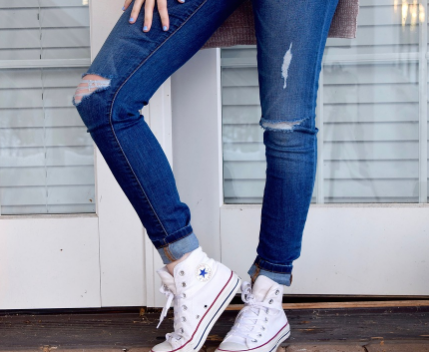Rationale Behind Dress Codes: Madison High School’s Take On a Longstanding Controversy

Pair of ripped jeans that may violate the dress code.
The Dress Code is a what students generally understand to be stipulations and restrictions on what we can wear due to school policy. However, I felt that instead of complaining to ourselves we would get a take from the administration themself. I spoke to Mr. Dreschel (DD) who is now Vice Principal of Madison High School and is in charge of enforcing rules among the student body. Handling the dress code in specific is one of his many responsibilities as the Vice Principal.
MDO: In a school District, What is the point of a dress code?
DD: The point of a dress code is to make it (school) a place where teachers and students and anybody else in the school feels comfortable with the people around them and with the way they, themselves are dressed. In a way that upholds professionalism and teaches appropriate dresswear with regards to the students as well.
MDO: Do think the school dress codes, especially the dress code in this school, has a lot of room for ambiguity?
DD: Yes, 100% yes. So the issue we have is that students don’t know (the specific rules of the dress code), teachers don’t know so the people who are enforcing it don’t know if they are enforcing it correctly. When it is enforced students will claim that other students are wearing the same thing that they are wearing. I think our goal is to become consistent overall and to become consistent in a way that our dress code becomes measurable so that we do not have that ambiguity. This so that students know that their clothes have to be a certain length or follow a certain guideline. There is definitely more then just wiggle room.
MDO: One of the more upsetting the provisions that have been expressed by girls in this school is the rule about the shoulders not showing, a lot young women tend to feel this rule is out of line and that this rule is too strict. What would you say to that?
DD: That is definitely a discussion we would have to have , obviously we live in a different world and a different timeframe than when these dress code rules were enforced. I personally do not think that girls should be told that they can’t show their shoulders. There are many nice, professional outfits where shoulders can be shown but again I think there might need to be a discussion about the certain length of the straps around the shoulders. Ultimately, fashion changes and continue to change and somethings now are more or less fashionable than they were then. This we might have to readdress our dress code more frequently and that should definitely be discussed more.
MDO: As a person in education do you understand where a student, particularly a female student, is coming from when she or he in some cases is upset with the dress code?
DD: Yes, but I think what kids lose sight of is that we were once kids too and it wasn’t too long ago that I was just in highschool or in college. Frankly my dressing never really affected the dress code because I would something like a T-shirt and shorts or pants and for most boys it is still that case. So then people would ask, “Oh are we just addressing the girls?”. No, we are addressing everyone, the rules apply to everybody, it’s just that outfits for girls are different from outfits for guys. It not supposed to be perceived that way (sexist). We just need to teach our and guide our students to knowing what is appropriate and what isn’t.
Mr. Drechsel makes it clear that the dress code provisions are not meant to be sexist and objectifying at all and many school district that was also not the intention at all. However many popular opinion from around the country continue to make this hard to believe. Last month in California, a student from Burbank High School named Virginia Bakakis was pulled out one of her honors classes because she was wearing a top with straps that were too thin. It was 110 degrees that day in California and Bakakis expressed to many in charge that this type of profiling was sexist and inappropriate. In 2015 sixteen year-old Gabi Finlayson from Lone Peak High School in Utah was then addressed by her school for wearing a dress that was supposedly too revealing to a school dance which resulted in her wearing a winter coat most of night. Finlayson expressed that she was embarrassed and ashamed all for wanting to feel beautiful in dress she loved.
From hearing these stories time in and time out, it is hard for young women to not feel profiled and targeted for simply wearing the clothes they think they feel comfortable in. What actually makes it harder is the fact that our fashions of 2017 may not conform to the regular dress code that, not only Madison, but many school districts instill. One browse through a seventeen magazine back to school outfit recommendation piece and one would without a doubt see denim mini skirts and off-the-shoulder clothing. Of course, these clothing items can be worn tastefully but they still aren’t technically “school appropriate”.
What the issue may be here is the blurred lines between something being deemed as “inappropriate” and a clothing item just “showing some skin”. With regards to the general complaints one would hear from girls being dress coded, steps may need to be taken by both the administration and students as to what is tastefully acceptable to wear to school and what is not. The people who administer rules need to clear up on the ambiguity of the dress code and also understand that skin can indeed be shown tastefully without it being innapropriate. The students also need to understand that what one should wear to school should not be clouding over the the main point of school which is to learn, and maybe simpler clothing can be worn to school while the trendier clothing can be worn to a more special occasion or hangout.
Stiegman, Kelsey. “17 Essential Pieces Every Girl Needs In Her Closet For Back to School.” Seventeen, Seventeen, 18 July 2017, www.seventeen.com/fashion/trends/g2851/back-to-school-clothes-fall-2016/.
Weingus, Leigh. “Teen Asked To Cover Up Partially Exposed Shoulders At High School Dance.” The Huffington Post, TheHuffingtonPost.com, 29 Jan. 2015, www.huffingtonpost.com/entry/school-dance-cover-up-exposed-shoulders_n_6571396.html.
Wallace, Kelly. “Do School Dress Codes Body-Shame Girls?” CNN, Cable News Network, 30 May 2017, www.cnn.com/2017/05/30/health/school-dress-codes-body-shaming-girls-parenting/index.html.

Alex Mroczko • Nov 29, 2017 at 12:53 pm
I understand the need for some guidelines regarding dress code, because school is a learning environment and students need to remain focused. However, some people believe that exposing shoulders and others things like that are distracting male students and even teachers. I think there needs to be a discussion to clarify what constitutes distraction in a learning environment.
Jordan Lederman • Nov 27, 2017 at 8:42 pm
I find this article really stimulating. The females in a lot of school systems are struggling to express themselves due to the harsh restrictions that they have on them regarding clothing. Though the dress codes may be for everyone, the specifically target things only made in women’s fashion, therefore targeting girls in particular. I think its hard to balance a dress code and make everyone happy, but I do not think that girls should be shamed for showing things such as shoulders or collar bones just because they are girls. Really well written article, Swarna!
Hannah Beneroff • Nov 27, 2017 at 5:02 pm
I think that this article is informative because it gives a different point of view about the dress code and it is nice to see what the other side has to say. However, these situations discussed in the article are very real and happening at MHS, and still not much is being done about it.
Charlotte Scaff • Nov 27, 2017 at 1:39 pm
When I hear the dress code described, the words that are often used are ‘appropriate’ and ‘professional’; these have different meanings for every single person, and that makes it difficult for every person to follow it.
Swarna Gowtham • Nov 27, 2017 at 9:22 am
I totally agree Sophia.
Swarna Gowtham • Nov 26, 2017 at 7:28 pm
Thank you so much for your insight Jesse. I see how your situation was frustrating, a teacher should not comment on your clothes just for the sake of sharing their opinion.
sophia haralampoudis • Nov 26, 2017 at 6:31 pm
I think that this article is really interesting because it is something that girls in the high school often have issues with. I think that the point brought up that some girls will get in trouble for wearing a certain shirt, but another girl wearing the same shirt will get away with it is very true and all comes back to the point that the faculty at MHS as well as the students just don’t really know what exactly the dress code is.
Jessie Kessler • Nov 26, 2017 at 12:54 pm
Mr. Dreschel said “the people who are enforcing it don’t know if they are enforcing it correctly.” I think this is incredibly true. I think the staff and faculty don’t know how to appropriately address “inappropriate clothing.” I’ve heard many stories from friends being dress coded about how unprofessional the enforcers can be when dress coding students. The enforcers are immature, not willing to reason, and forcing their ideas on the physical looks of the student body onto young minds. Recently (November 2017), I was approached by a teacher regarding my slitted leggings (which I have worn for the past 3 years at MHS without incident), this teacher said, “Aren’t you looking fashionable today.” At first I thought it was a compliment, and was feeling pretty good about myself. Then I noticed the teacher was still looking at my pants which was an uncomfortable feeling. After a few moments the teacher said, “but if my mother saw those she would have a field day patching them up.” This comment was inappropriate, undermining, and objectifying and pretty much ruined by day. What made it worse was the teacher didn’t even dress code me. They just wanted to share their unwanted and innapropriate opinion about my pants. And spread even more negativity in the school. In my opinion, someone’s perception about what a woman should wear to school should be not be connected to the dress code. Enforce the code, not your opinion. And if you are objectifying my slitted leg gins, you are the problem not me.